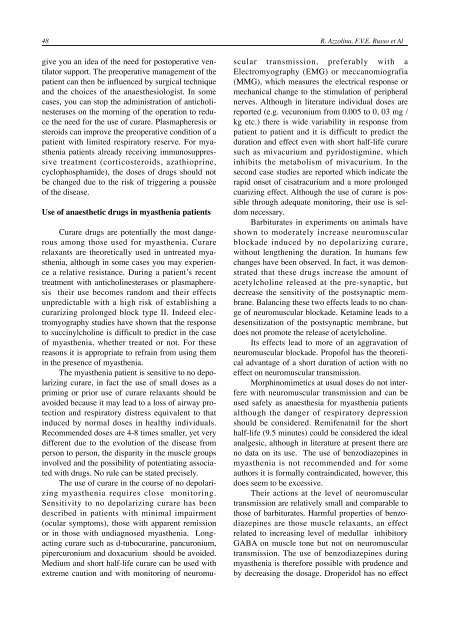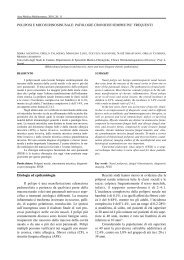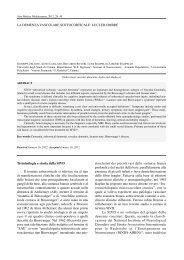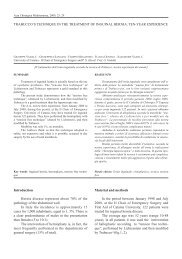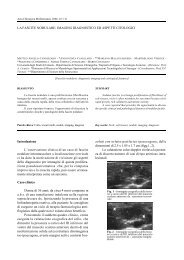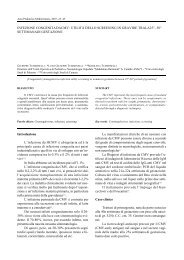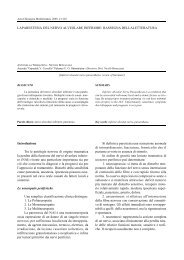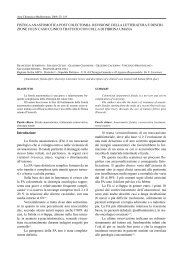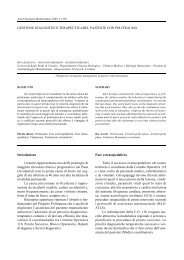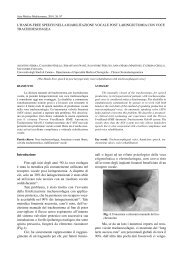RESPONSE TO ANAESTHETIC DRUGS IN ... - Carbone Editore
RESPONSE TO ANAESTHETIC DRUGS IN ... - Carbone Editore
RESPONSE TO ANAESTHETIC DRUGS IN ... - Carbone Editore
You also want an ePaper? Increase the reach of your titles
YUMPU automatically turns print PDFs into web optimized ePapers that Google loves.
48 R. Azzolina, F.V.E. Russo et Al<br />
give you an idea of the need for postoperative ventilator<br />
support. The preoperative management of the<br />
patient can then be influenced by surgical technique<br />
and the choices of the anaesthesiologist. In some<br />
cases, you can stop the administration of anticholinesterases<br />
on the morning of the operation to reduce<br />
the need for the use of curare. Plasmapheresis or<br />
steroids can improve the preoperative condition of a<br />
patient with limited respiratory reserve. For myasthenia<br />
patients already receiving immunosuppressive<br />
treatment (corticosteroids, azathioprine,<br />
cyclophosphamide), the doses of drugs should not<br />
be changed due to the risk of triggering a poussèe<br />
of the disease.<br />
Use of anaesthetic drugs in myasthenia patients<br />
Curare drugs are potentially the most dangerous<br />
among those used for myasthenia. Curare<br />
relaxants are theoretically used in untreated myasthenia,<br />
although in some cases you may experience<br />
a relative resistance. During a patient’s recent<br />
treatment with anticholinesterases or plasmapheresis<br />
their use becomes random and their effects<br />
unpredictable with a high risk of establishing a<br />
curarizing prolonged block type II. Indeed electromyography<br />
studies have shown that the response<br />
to succinylcholine is difficult to predict in the case<br />
of myasthenia, whether treated or not. For these<br />
reasons it is appropriate to refrain from using them<br />
in the presence of myasthenia.<br />
The myasthenia patient is sensitive to no depolarizing<br />
curare, in fact the use of small doses as a<br />
priming or prior use of curare relaxants should be<br />
avoided because it may lead to a loss of airway protection<br />
and respiratory distress equivalent to that<br />
induced by normal doses in healthy individuals.<br />
Recommended doses are 4-8 times smaller, yet very<br />
different due to the evolution of the disease from<br />
person to person, the disparity in the muscle groups<br />
involved and the possibility of potentiating associated<br />
with drugs. No rule can be stated precisely.<br />
The use of curare in the course of no depolarizing<br />
myasthenia requires close monitoring.<br />
Sensitivity to no depolarizing curare has been<br />
described in patients with minimal impairment<br />
(ocular symptoms), those with apparent remission<br />
or in those with undiagnosed myasthenia. Longacting<br />
curare such as d-tubocurarine, pancuronium,<br />
pipercuronium and doxacurium should be avoided.<br />
Medium and short half-life curare can be used with<br />
extreme caution and with monitoring of neuromu-<br />
scular transmission, preferably with a<br />
Electromyography (EMG) or meccanomiografia<br />
(MMG), which measures the electrical response or<br />
mechanical change to the stimulation of peripheral<br />
nerves. Although in literature individual doses are<br />
reported (e.g. vecuronium from 0.005 to 0, 03 mg /<br />
kg etc.) there is wide variability in response from<br />
patient to patient and it is difficult to predict the<br />
duration and effect even with short half-life curare<br />
such as mivacurium and pyridostigmine, which<br />
inhibits the metabolism of mivacurium. In the<br />
second case studies are reported which indicate the<br />
rapid onset of cisatracurium and a more prolonged<br />
cuarizing effect. Although the use of curare is possible<br />
through adequate monitoring, their use is seldom<br />
necessary.<br />
Barbiturates in experiments on animals have<br />
shown to moderately increase neuromuscular<br />
blockade induced by no depolarizing curare,<br />
without lengthening the duration. In humans few<br />
changes have been observed. In fact, it was demonstrated<br />
that these drugs increase the amount of<br />
acetylcholine released at the pre-synaptic, but<br />
decrease the sensitivity of the postsynaptic membrane.<br />
Balancing these two effects leads to no change<br />
of neuromuscular blockade. Ketamine leads to a<br />
desensitization of the postsynaptic membrane, but<br />
does not promote the release of acetylcholine.<br />
Its effects lead to more of an aggravation of<br />
neuromuscular blockade. Propofol has the theoretical<br />
advantage of a short duration of action with no<br />
effect on neuromuscular transmission.<br />
Morphinomimetics at usual doses do not interfere<br />
with neuromuscular transmission and can be<br />
used safely as anaesthesia for myasthenia patients<br />
although the danger of respiratory depression<br />
should be considered. Remifenatnil for the short<br />
half-life (9.5 minutes) could be considered the ideal<br />
analgesic, although in literature at present there are<br />
no data on its use. The use of benzodiazepines in<br />
myasthenia is not recommended and for some<br />
authors it is formally contraindicated, however, this<br />
does seem to be excessive.<br />
Their actions at the level of neuromuscular<br />
transmission are relatively small and comparable to<br />
those of barbiturates. Harmful properties of benzodiazepines<br />
are those muscle relaxants, an effect<br />
related to increasing level of medullar inhibitory<br />
GABA on muscle tone but not on neuromuscular<br />
transmission. The use of benzodiazepines during<br />
myasthenia is therefore possible with prudence and<br />
by decreasing the dosage. Droperidol has no effect


